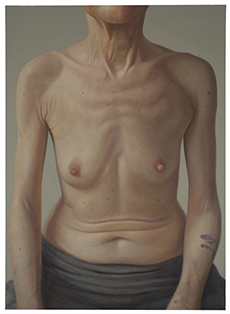Kjerstin Kauffman
Lullaby
for Linus
What secrets, neatly pursed
Inside your quiet brain
Leap out now, while you sleep?
What blossoms burst,
What sparks and glints escape
That once were locked away
As embryo and grain?
I'd like to see their shape,
I'd like to bare that world,
Where sharp, orphan dreams
First flash and constellate.
But you lie closed, curled
Against me, and your face
Is masky, and at peace.
I have no skill to breach
That hidden place.
So, hush, Linus, sleep,
So let me have this grief,
So let those bursting dreams
Be yours to keep.
Meditation
The mind's a labyrinth. Better yet, a hive
I crawl inside, queen of the looping flight
and dizzy humming. The bees are mine, each white
and crescent egg of them, and I contrive
what kind of bee they'll be when they arrive.
I lay them out of instinct. It feels right.
And yet, once they're released, I conquer fright
only with artful care. Will they survive?
Thrive in their separate roles? And if they do,
what world have I, inside here, brought them to?
Sometimes I try to follow them, to find
the paths they learn to take beyond my mind.
But then I end up here, in this golden room:
birthplace, passage, fragrant storehouse, tomb.
|
|
 |
 |
|
|
 |
 |
Jenna Le, Anne-Marie Thompson, and Chelsea Woodard join editor Kim Bridgford at the tenth-anniversary Mezzo Cammin panel at the Poetry by the Sea conference.
Sophia Galifianakis was the recipient of the Mezzo Cammin scholarship.
|
|
|
 |
|
|
|
 |
Corpus VI was formed in 2003, when six women figurative painters, who studied together at the Pennsylvania Academy of the Fine Arts, united to curate, exhibit and present our work to the public on our own terms, and launch our artistic careers. The name was chosen because it reflected our shared commitment to figurative representation. Clarity Haynes, Elena Peteva, and Suzanne Schireson were three of the founding members of the group, which organized an inaugural, self-titled show at Philadelphia's Highwire Gallery in the spring of 2005. The exhibition essay was written by Jeffrey Carr, Dean of the Pennsylvania Academy of the Fine Arts. The exhibition was very well-attended and reviewed in several art publications.
The experience of working together to successfully realize this exhibition, as well as the continuous dialogue and exchange of ideas on contemporary figuration, has proven to be greatly valuable to us. Ten years after graduating from PAFA, as our careers have taken us to different locations across the United States, three of the original members, Clarity Haynes, Suzanne Schireson, and Elena Peteva, have come together to reinvent the collective by inviting one artist each to be part of this exhibition that will begin at the New Bedford Art Museum in fall 2015 and travel to other institutions.
Holly Trostle Brigham, Stacy Latt Savage and Laurie Kaplowitz are professional figurative artists, whose strong artistic visions enrich the collective's range and explorations of contemporary representation. We are excited at the prospect of seeing our work all together in new configurations, creating new dialogues. Holly Brigham creates imaginative, narrative watercolors, which tell a feminist story, inserting her artistic persona into art historical narratives and mythologies. Laurie Kaplowitz uses textured paint to create personages that hint at the soul within, alluding to rituals of marking, scarring and adorning the body as an integral part of our human identity and presentation. Stacy Latt Savage combines figurative elements with fabricated structures and shapes to create objects that capture what it looks like to feel human and the complexities of our human condition. Clarity Haynes casts new light on ideas of beauty, femininity and embodiment through her realistic painted portraits of the female torso. Elena Peteva creates allegorical representations of our individual and social states through the human figure and subtle, charged, incomplete signs that invite the viewer's attempt for interpretation. Suzanne Schireson is influenced by her great-grandfather's autobiography as an early plastic surgeon and her paintings examine contradictions surrounding the birth of cosmetic surgery, such as the power to heal and the fostering of insecurity.
|
|
|
|
|
|
 |
|
 |
|
|
|
|
